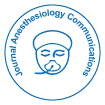Is Irrational Use of Intramyometrial Vasopressin Justified in Anesthesia Practice?
Received: 23-Oct-2017 / Accepted Date: 25-Oct-2017 / Published Date: 30-Oct-2017
Keywords: Vasopressin; cardiopulmonary resuscitation; bradycardia; intra-myometrial vasopressin
Editorial
Vasopressin is a type of hormone, secreted from the hypothalamus into circulation via posterior pituitary gland. Anesthesiologists have been utilizing its useful effects in cardiopulmonary resuscitation, hypotension, diabetes insipidus etc. Intra-myometrial vasopressin has found a role in management of uterine myomas as it acts by constricting the smooth muscles in the walls of capillaries, small arterioles and venules and hence prevents bleeding. The vasoconstrictive effect is manifested within seconds with a half-life of 10-20 min with duration lasting 2-8 h. Vasopressin is often used to reduce bleeding during surgery, but its systemic effects can be pronounced and can pose lot of challenges to the attending anesthesiologist. Laxmi et al. [1] reported the occurrence of severe vasospasm and decrease in amplitude to complete absence of waveforms and reading of pulse oximetry, along with significant fall in blood pressure. However, there was no change in ECG or end tidal carbon dioxide values. This was seen to occur 30 min after induction of anesthesia, when surgeons injected 20 units of vasopressin intra-myometrially diluted in 200 ml of normal saline after negative aspiration of blood. Hung et al. [2] described two cases, in which patients had bradycardia followed by cardiac arrest and pulmonary edema, intra-myometrial vasopressin was used in diluted concentration (2 units/ml) during open myomectomy. Zullo et al. [3] also described a case in which patient had bradycardia followed by pulmonary edema and atrio-ventricular block, after the local injection of 10 ml of diluted vasopressin (2 units/ml). Similarly, severe hypotension leading to not recordable BP with normal ECG complexes, with patient complaining of nausea and vomiting have been described by Chilkoti et al. [4] Atropine 0.6 mg was given intravenously and on enquiring surgeons it was found that they had injected 10-15 ml of 0.1 u/ml vasopressin (equivalent to 1-1.5 Units) into the myometrium, other causes of hypotension were ruled out and within 5 min, patient had normal HR and BP of 170/90 mmHg. Although low dosage of intrauterine vasopressin has been used safely by many, hemodynamic side effects have been seen with dosage exceeding 5 units. Frishman [5] suggested a routine dose of 2 units of intra-myometrial vasopressin and maximum of 4-6 units to avoid complications. Deschamps et al. [6] have described severe bradycardia and AV blockade after injecting 3 units of intra-myometrial vasopressin. Alexander GD [7] and Hobo et al. [8] have recommended that diluted concentration of vasopressin should be less than 0.05-0.3 units/ml to avoid lethal complications. Therefore, maximum dosage of intra-myometrial vasopressin remains questionable. Hence, we conclude that although vasopressin has proven hemostatic properties in preventing blood loss during myomectomy, but there have been instances of reported cardiac and pulmonary complications. Till further literature on safety profile, concentration and maximum dosage becomes available, routine use of vasopressin in myomectomy procedures should be ascertained. Anesthesiologist should also be well versed with the side effects of vasopressin such as chest pain, tightness in chest, abdominal discomfort, backache, extreme fatigue, dizziness, difficulty in swallowing, lethargy, nausea, vomiting, puffiness, hypotension and cardiac arrest and be prepared for all adverse outcomes.
References
Citation: Kakkar B (2017) Is Irrational Use of Intramyometrial Vasopressin Justified in Anesthesia Practice?. Anesth Commun 1: e002.
Copyright: ©2017 Kakkar B. This is an open-access article distributed under the terms of the Creative Commons Attribution License, which permits unrestricted use,distribution, and reproduction in any medium, provided the original author and source are credited.
Share This Article
黑料网 Journals
Article Usage
- Total views: 3397
- [From(publication date): 0-2017 - Mar 10, 2025]
- Breakdown by view type
- HTML page views: 2716
- PDF downloads: 681
